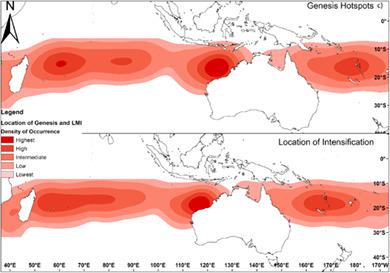当前位置:
X-MOL 学术
›
Int. J. Climatol.
›
论文详情
Our official English website, www.x-mol.net, welcomes your
feedback! (Note: you will need to create a separate account there.)
Southern hemisphere tropical cyclones: A critical analysis of regional characteristics
International Journal of Climatology ( IF 3.5 ) Pub Date : 2020-04-23 , DOI: 10.1002/joc.6613 Micheal T. Pillay 1 , Jennifer M. Fitchett 1
International Journal of Climatology ( IF 3.5 ) Pub Date : 2020-04-23 , DOI: 10.1002/joc.6613 Micheal T. Pillay 1 , Jennifer M. Fitchett 1
Affiliation

|
The destructive nature of tropical cyclones poses a risk to the regions where they occur during and after landfall. Southern hemisphere countries are usually more vulnerable to these risks and impacts due to their lower adaptive capacity. Research for the northern hemisphere has comprehensively explored the nature of tropical cyclones. This information has since been applied to long‐term adaptation plans and short‐term evacuation plans. This study interrogates the characteristics and nature of Southern Hemisphere tropical cyclones and critically explores their differences to Northern Hemisphere storm characteristics. The differences found between the hemispheric storm activities include seasonality, number of storms and the latitudinal position at which these storms undergo genesis and intensification. Similarities were found in storm intensity, which was observed to increase with the time taken to reach maximum lifetime intensity. Higher sea surface temperatures were similarly found to be a major factor associated with increased intensity and lifetime of Southern Hemisphere tropical cyclones. Tropical cyclone seasonality is also centred around the warmer months within each hemisphere. Compared to the Northern Hemisphere the tropical cyclone seasonal length indicates no increase. The magnitude of sea surface temperature increase is also lower in the Northern Hemisphere. These fundamental links observed with temperature in both hemispheres implicates climate warming and its impact on tropical cyclones in both hemispheres, regardless of their seasonality and frequency.
中文翻译:

南半球热带气旋:区域特征的批判性分析
热带气旋的破坏性给登陆期间和登陆后发生的区域带来风险。由于南半球国家的适应能力较低,因此通常更容易受到这些风险和影响。对北半球的研究全面探索了热带气旋的性质。此信息此后已应用于长期适应计划和短期疏散计划。这项研究询问了南半球热带气旋的特征和性质,并批判性地探讨了它们与北半球风暴特征的差异。在半球风暴活动之间发现的差异包括季节性,风暴数量以及这些风暴发生和加剧的纬度位置。发现风暴强度相似,观察到随着达到最大寿命强度所花费的时间增加。同样,海平面温度升高也是与南半球热带气旋强度和寿命增加相关的主要因素。热带气旋的季节性也集中在每个半球的温暖月份。与北半球相比,热带气旋的季节长度没有增加。北半球的海表温度升高幅度也较小。在两个半球中观察到的这些基本联系暗示了气候变暖及其对两个半球中热带气旋的影响,而与季节和频率无关。同样,海平面温度升高也是与南半球热带气旋强度和寿命增加相关的主要因素。热带气旋的季节性也集中在每个半球的温暖月份。与北半球相比,热带气旋的季节长度没有增加。北半球海表温度升高的幅度也较低。在两个半球中观察到的这些基本联系暗示了气候变暖及其对两个半球中热带气旋的影响,而与季节和频率无关。同样,海平面温度升高也是与南半球热带气旋强度和寿命增加相关的主要因素。热带气旋的季节性也集中在每个半球的温暖月份。与北半球相比,热带气旋的季节长度没有增加。北半球的海表温度升高幅度也较小。在两个半球中观察到的这些基本联系暗示了气候变暖及其对两个半球中热带气旋的影响,而与季节和频率无关。热带气旋的季节性也集中在每个半球的温暖月份。与北半球相比,热带气旋的季节长度没有增加。北半球的海表温度升高幅度也较小。在两个半球中观察到的这些基本联系暗示了气候变暖及其对两个半球中热带气旋的影响,而与季节和频率无关。热带气旋的季节性也集中在每个半球的温暖月份。与北半球相比,热带气旋的季节长度没有增加。北半球海表温度升高的幅度也较低。在两个半球中观察到的这些基本联系暗示了气候变暖及其对两个半球中热带气旋的影响,而与季节和频率无关。
更新日期:2020-04-23
中文翻译:

南半球热带气旋:区域特征的批判性分析
热带气旋的破坏性给登陆期间和登陆后发生的区域带来风险。由于南半球国家的适应能力较低,因此通常更容易受到这些风险和影响。对北半球的研究全面探索了热带气旋的性质。此信息此后已应用于长期适应计划和短期疏散计划。这项研究询问了南半球热带气旋的特征和性质,并批判性地探讨了它们与北半球风暴特征的差异。在半球风暴活动之间发现的差异包括季节性,风暴数量以及这些风暴发生和加剧的纬度位置。发现风暴强度相似,观察到随着达到最大寿命强度所花费的时间增加。同样,海平面温度升高也是与南半球热带气旋强度和寿命增加相关的主要因素。热带气旋的季节性也集中在每个半球的温暖月份。与北半球相比,热带气旋的季节长度没有增加。北半球的海表温度升高幅度也较小。在两个半球中观察到的这些基本联系暗示了气候变暖及其对两个半球中热带气旋的影响,而与季节和频率无关。同样,海平面温度升高也是与南半球热带气旋强度和寿命增加相关的主要因素。热带气旋的季节性也集中在每个半球的温暖月份。与北半球相比,热带气旋的季节长度没有增加。北半球海表温度升高的幅度也较低。在两个半球中观察到的这些基本联系暗示了气候变暖及其对两个半球中热带气旋的影响,而与季节和频率无关。同样,海平面温度升高也是与南半球热带气旋强度和寿命增加相关的主要因素。热带气旋的季节性也集中在每个半球的温暖月份。与北半球相比,热带气旋的季节长度没有增加。北半球的海表温度升高幅度也较小。在两个半球中观察到的这些基本联系暗示了气候变暖及其对两个半球中热带气旋的影响,而与季节和频率无关。热带气旋的季节性也集中在每个半球的温暖月份。与北半球相比,热带气旋的季节长度没有增加。北半球的海表温度升高幅度也较小。在两个半球中观察到的这些基本联系暗示了气候变暖及其对两个半球中热带气旋的影响,而与季节和频率无关。热带气旋的季节性也集中在每个半球的温暖月份。与北半球相比,热带气旋的季节长度没有增加。北半球海表温度升高的幅度也较低。在两个半球中观察到的这些基本联系暗示了气候变暖及其对两个半球中热带气旋的影响,而与季节和频率无关。










































 京公网安备 11010802027423号
京公网安备 11010802027423号